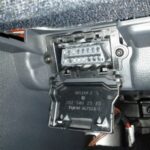The 1999 24v Cummins ISB utilizes an OBD2 port for diagnostics. This port allows communication with the Engine Control Module (ECM) via the same CCD bus used by other modules like the PCM, BCM, and instrument cluster. This article explores how this system works, addresses common questions about tuning, and clarifies the role of aftermarket devices like the FASS fuel system and Comp boxes.
Communicating with the 1999 24v Cummins ECM
The OBD2 port on a 1999 24v Cummins ISB utilizes the J1962 protocol for communication. This is the same protocol used by other modules on the vehicle’s CCD data bus. Tuners typically leverage this connection to access and modify the ECM’s calibration. However, for more in-depth diagnostics and programming, Cummins Insite software is often preferred. Insite requires a connection to the dedicated Cummins bus connector, utilizing the J1939 protocol. There’s no direct way for Insite to communicate via the OBD2 port’s J1962 channel without specialized adaptations.
FASS Fuel System Installation and ECM Interaction
When installing a FASS fuel system on a 1999 24v Cummins, it’s recommended to mount the unit as close to the fuel tank as possible, ideally below it to ensure optimal fuel delivery. This often allows for the removal of the factory lift pump mounted on the engine block. While generally reliable, some users have reported issues with FASS pump motors. It’s important to note that the FASS system interacts with the engine mechanically by providing fuel, but it doesn’t directly communicate with or alter the ECM’s programming.
Power Levels, Tuning, and Component Considerations
The power output of a 1999 24v Cummins ISB is primarily determined by the PCM (Powertrain Control Module) calibration, commonly referred to as the “tune.” Different power levels often require corresponding hardware changes, such as upgraded pistons, injectors, injection pumps, and manifolds, to ensure reliability and durability at higher outputs. While it’s possible to load a higher horsepower tune onto a lower horsepower engine, the actual gains may not match the tune’s advertised increase without the necessary supporting modifications. Upgrading both the tune and the corresponding hardware components is generally recommended for optimal performance and longevity.
Understanding Comp Boxes and Their Impact
Comp boxes, unlike tuners, don’t directly modify the ECM’s calibration. They work by manipulating sensor inputs to the ECM, effectively tricking it into operating under different conditions than actual. This can lead to increased fuel delivery and boost pressure, resulting in higher power output. While effective, this indirect method of performance enhancement is not always preferred due to its potential impact on engine longevity and emissions.
Conclusion: Navigating the 1999 24v Cummins ISB System
Understanding the intricacies of the 1999 24v Cummins ISB’s OBD2 system, ECM communication, and the impact of modifications like FASS systems and Comp boxes is crucial for proper diagnostics, tuning, and maintenance. While the OBD2 port provides access to essential engine data, specialized tools and knowledge are required for more advanced tasks. Always consult with experienced professionals for complex diagnostics and tuning procedures.
